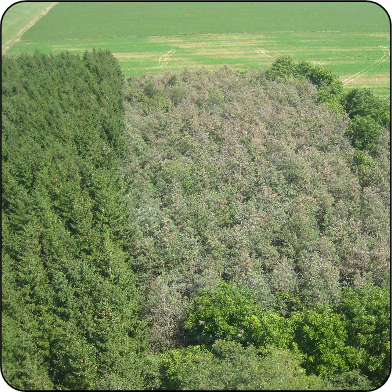Brown spot needle blight
Information about brown spot needle blight (Mycosphaerella dearnessii), a forest disease found in Ontario.
Overview
- Native to North America.
- Brown-spot needle blight is a disease that kills foliage and slows growth in pine.
- The disease causes brown needle spots, needle browning, and needle drop.
- Most damaging on low branches and small trees.
- The disease seldom kills trees but can cause significant defoliation on 2- and 3-year-old needles with current year needles also being infected in severe disease years.
Host species
Scots (Pinus sylvestris) and Austrian pine (Pinus nigra) are most commonly affected, but all pine species are susceptible to infection.
Characteristics and life cycle
- Disease overwinters on dead infected needles remaining on the tree and on the ground and is spread though spores distributed by wind, rain splash and contaminated equipment.
- Warm wet weather is required for spores to germinate and penetrate healthy needles.
- Most infections occur in late spring and can take several months for symptoms to appear; needle tip browning and spots begin to develop over the summer and into the fall.
- In late summer and into the fall fruiting bodies form on infected needles in the tree and on the ground.

Symptoms and damage
- Brown or reddish brown needles that drop prematurely are characteristic of this disease.
- Branches look bare from accelerated 2nd and 3rd year needle losses with only tufts of current year needles remaining.
- Damage is first noticeable in the lower branches.
- Yellow and tan spots appear early in the summer, later coalescing into brown bands with yellow halos encircling the needle by late summer and fall.
- Resin is frequently found on spots.
- Infected needles commonly have dead brown tips, yellow and brown bands and green bases.
- In late summer, fall and into the following spring, black fruiting bodies can be seen with noticeable tearing of the needle epidermis.

Control measures
Remove and dispose of all infected material, including needles on the ground if practical. For Christmas tree plantations and highly valued ornamental trees, the use of fungicides may be necessary.
Updated: May 20, 2021
Published: July 18, 2014